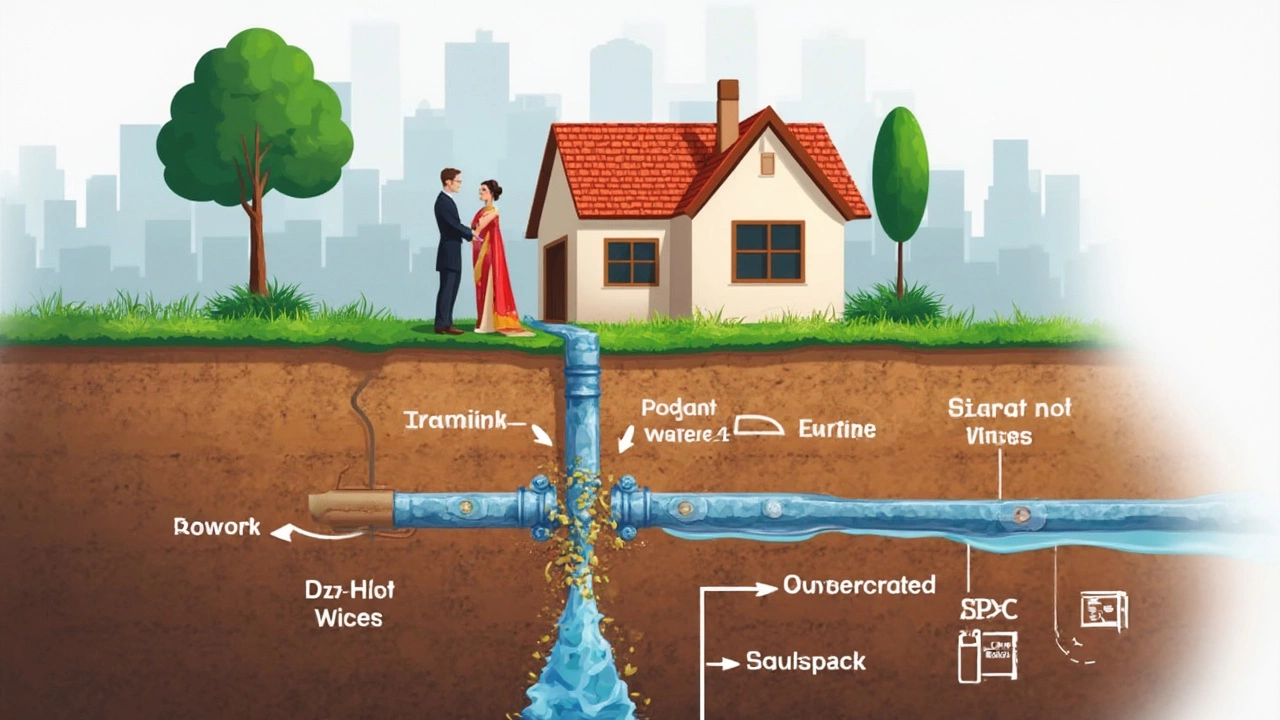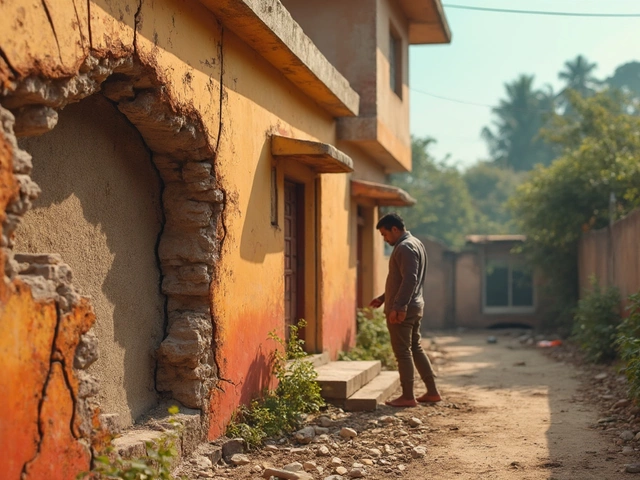Nothing makes your heart sink faster than the thought of a busted pipe hiding way below your floors. The first question that pops up: Will insurance help cover the mess under my foundation?
The answer is—it depends, and it depends a lot. Homeowners insurance isn’t built to cover every pipe that cracks or leaks. Usually, a standard policy kicks in when the leak is sudden and accidental. Think burst pipes during a winter freeze, not years of slow dripping and rusting. If a sudden pipe break floods your basement or seeps into your living room, there’s a good shot your policy helps with the cleanup and repairs to the house itself. But here’s the tricky part: fixing the actual broken pipe under the slab is often a different story. Most policies draw a line there.
But don’t just assume you’re on your own. Read your insurance papers—or better yet, call your agent and get them to explain what’s covered. Remember, water damage isn’t always treated the same as plumbing repair costs. That split matters a lot for your wallet.
- What Counts as a Broken Pipe Under the Foundation?
- When Does Homeowners Insurance Pay for Slab Leaks?
- Why Your Claim Might Get Denied
- Tips for Filing a Successful Insurance Claim
- Preventing Pipe Problems Under Your Foundation
- When to Call a Pro: Knowing Your Limits
What Counts as a Broken Pipe Under the Foundation?
So, what are we actually talking about when we say "broken pipe under the foundation"? It's usually a water or sewer line that runs right under your concrete slab—the thick chunk of concrete acting as your house’s base. These pipes carry water to your sinks, showers, toilets, and carry waste back out. When they leak, crack, or burst, all that water has nowhere to go but into the soil or up into your home’s floors.
Underslab pipe breaks most often look like:
- Water pipes that snap due to foundation shifting or freezing temps
- Old pipes rusting or corroding over years of use
- Pipes cracked by tree roots growing underneath your slab
- Seams or joints in the plumbing coming apart
Here’s a quick rundown of telltale signs you might have a problem lurking out of sight:
- Sudden spikes in your water bill with no good reason
- Wet or warm spots on your floors, especially if you don’t have pets making mischief
- Mildew or musty smells hanging around
- Cracks in your tiles or foundation that seem to get worse over time
The scary part? You might not notice a broken pipe until lots of damage is done. Surveys show slab leaks account for about 20% of major plumbing claims in homes more than 30 years old.
| Typical Pipe Material | Average Lifespan |
|---|---|
| Galvanized Steel | 20-50 years |
| Copper | 50+ years |
| PEX | 40-50 years |
Foundation leaks are sneaky because your foundation acts like a barrier and hides everything below. But the longer you let leaking water run, the bigger the headache later—think cracked slabs and sky-high repair bills.
If you’re ever suspicious, don’t wait. A simple moisture test, a plumber with leak detection gear, or even using an infrared camera can save you a bundle down the line. One thing to keep in mind: homeowners insurance treats sudden breaks differently from slow, long-term leaks. Always check what kind of pipe problem you have before you call your insurance company.
When Does Homeowners Insurance Pay for Slab Leaks?
If you’ve just found out there’s water under your foundation, your main concern is probably whether you’re covered. The key thing to know is that homeowners insurance usually pays for sudden, accidental slab leaks—but not slow leaks from old pipes that have been corroding for years.
What counts as "covered"? Most policies protect you from things like:
- Frozen pipes that burst suddenly
- Leaking caused by a one-time, unexpected accident (like hitting a pipe while doing home improvements)
- Water damage to floors, walls, or personal property caused by the leak
But most insurance won’t help pay for:
- Replacing the old pipe itself, except in rare cases
- Leaks caused by normal wear-and-tear
- Damage that happened slowly over months or years
Think of it this way: if a freak cold snap busts your pipe and you catch the problem fast, your insurer will likely cover the water damage and maybe the cost of finding the leak. But if you ignored a spot on the wall that’s been growing for six months, you’re probably on your own for both repair and damages.
Here are some numbers that show how this plays out:
| Scenario | Insurance Coverage? |
|---|---|
| Burst pipe after freeze | Usually yes—damage covered, pipe repair may be extra |
| Cracked pipe from age | No—maintenance issue, not sudden |
| Leak after an earthquake | Not with standard policy—earthquake insurance extra |
| Hidden slab leak found after weeks | Usually denied—seen as a long-term problem |
If you’re ever not sure, snap pictures, keep damaged stuff, and talk to your agent fast. Fast action and evidence really help when you’re asking insurance to step in for a slab leak.
Why Your Claim Might Get Denied
If you’re counting on homeowners insurance to dig you out of trouble when pipes break under your foundation, don’t just assume it’ll be a smooth yes. Insurance companies deny a chunk of these claims for a few big reasons—and understanding them can make or break your chances of payout.
The main killer? Gradual damage. If your pipes have been leaking slowly for months or even years, the insurer will almost always slap your claim with a denial. Policies are built to cover quick, accidental disasters, not slow wear and tear. Anything labeled as "maintenance issues" usually isn’t covered at all.
Another common reason is lack of proof. If you can’t show the pipe burst out of nowhere, like in a crazy cold snap, adjusters won’t buy it. You’ll need photos, dates, maybe even plumber statements.
Here’s a handy list of reasons insurance companies might deny your claim:
- Pipe broke from old age, corrosion, or wear and tear (not a sudden event).
- Leak caused by neglect—like putting off little repairs for too long.
- No maintenance records or proof of regular plumbing checks.
- Type of water damage not covered (like groundwater or sewer backup unless you have extra coverage).
- Damage discovered way after it started, making it hard to prove when it happened.
Insurance adjusters look for any reason to save their company money. According to data from the Insurance Information Institute (III), about 1 in 50 insured homes files a water damage claim each year, but not all get paid out—especially for foundation leaks.
| Reason for Denial | Percent of Denied Claims (Estimated) |
|---|---|
| Gradual leaks/Neglect | 43% |
| Excluded type of water damage | 27% |
| Lack of documentation | 18% |
| Unpermitted repairs or DIY fixes | 12% |
Takeaway? Keep solid records on plumbing maintenance. Snap photos at the first sign of trouble. And read your policy so you know what’s covered before you ever hear water bubbling under the slab.

Tips for Filing a Successful Insurance Claim
If you ever spot water pooling on your floors or notice your walls are suddenly a little squishy, don’t just panic—get organized. The sooner you act and the clearer your case, the better your shot at getting your homeowners insurance to pick up the bill. Here’s how you keep things moving in your favor:
- Document Everything: Snap photos of the damage, the water source (if you can find it), and any spots where water has crept. Save videos too, especially if the leak is actively flowing. It’s hard for an adjuster to argue with plain evidence.
- Stop Further Damage: Shutting off your home’s water main can be a lifesaver. Insurance often denies claims if you ignore a leak or let additional damage occur. Do what you can (without risking your safety) to keep things from getting worse.
- Call Your Insurer Fast: Report your claim as soon as you notice the problem. Most companies want you to call within 24-48 hours. Waiting could give them a reason to push back or reduce your payout.
- Keep All Repair Bills and Receipts: Any plumber visits, mitigation equipment rentals, or emergency services—hang onto every document. These prove you did all you could to limit damage (and show what you spent).
- Don’t Rush Into Repairs: Unless it’s stopping more harm to your house, hold off on big repairs until the insurance adjuster has seen the damage. You don’t want them saying you fixed it before they could verify your story.
- Ask for Everything in Writing: Take notes during calls and ask your adjuster for a summary of what your policy will and won’t cover, including possible exclusions about pipes under slabs.
Want some hard data? Check this out: according to the Insurance Information Institute, water damage and freezing account for nearly 29% of all homeowner insurance claims nationwide. That speaks to how common this headache really is.
| Step | Reason |
|---|---|
| Document Damage | Makes your claim stronger with proof |
| Contact Insurer Promptly | Faster response, less reason for denial |
| Limit Further Damage | Shows you did your part as a homeowner |
| Keep Receipts | Helps you get reimbursed for legit expenses |
Dealing with insurance isn’t fun, but being ready with good notes and speedy action makes a huge difference. Think of it like building your own case—because, in a way, you are.
Preventing Pipe Problems Under Your Foundation
If your pipes are leaking under your foundation, you’re in for a tough time and a fat bill. Dodging that drama comes down to prevention. Old pipes, shifting soil, and steady moisture can all make a mess quick. Let’s get into some straight-up tactics to protect your place—and your wallet.
- Regular Plumbing Inspections: Have a plumber check your system at least once a year. Pro tip: ask them if they use video cameras to look inside the pipes. Catching small things (like mineral buildup or corrosion) early is way cheaper than a whole slab repair.
- Watch Your Water Bill: If your bill shoots up but your habits haven’t changed, you might have a slow leak somewhere underground. That’s an early sign things are about to get expensive.
- Keep Soil Moisture Even: Pipes hate wild swings in moisture. Running soaker hoses during hot, dry months—especially if you have a slab foundation—evens out pressure and helps prevent the ground from shrinking and shifting your pipes out of place.
- Don’t Ignore Signs: Wet spots on your floors, mysterious mildew, or that classic musty smell? Don’t wait it out. The longer water sits, the bigger your problems (and bills) get.
- Use the Right Materials: If your home’s older than 1980 and you’re remodeling, upgrade old galvanized or cast-iron pipes. Modern copper or PEX pipes handle shifting and corrosion better, especially under a slab.
Getting proactive makes a real difference. According to the Insurance Information Institute, water damage from plumbing leaks (including under foundations) costs U.S. homeowners over $10 billion every year. That’s serious cash, considering many of those headaches could’ve been prevented.
| Common Pipe Problem | Warning Sign | Prevention Tip |
|---|---|---|
| Corrosion | Rusty water, flakes, low pressure | Upgrade old pipe materials |
| Soil Shifting | Cracks in floors/walls, foundation movement | Keep consistent soil moisture |
| Hidden Leaks | Unexplained water bills, damp floors | Annual inspections, monitor water use |
Stay on top of these things and you’ve got a much better shot at avoiding those nightmare slab leaks. A little prevention, some cheap sensors, and a good plumber go a long way when it comes to homeowners insurance not having to get involved in the first place.
When to Call a Pro: Knowing Your Limits
Trying to DIY a pipe repair under your house foundation is a risky move unless you’re a licensed plumber with the right equipment. Most slab leaks need special tools to spot and fix—like electronic leak detectors, sonar, or even tiny cameras. This stuff costs a ton and isn’t made for weekend projects, so your best bet is to call a pro as soon as you suspect trouble.
There are a few classic signs you shouldn’t ignore:
- Your water bill spikes and you can’t find a leak anywhere else.
- Your floors feel oddly warm or wet in certain spots.
- You spot cracks or warping in the walls and floors.
- There’s a weird musty smell that won’t go away.
- You hear running water when all the faucets are off.
According to the American Society of Home Inspectors, about 60% of U.S. homes have some sort of underground water problem, and a hidden slab leak is among the trickiest. Water damage from these leaks can lead to expensive foundation repair, mold, and even mess with the structural safety of your home.
| Warning Sign | What It Might Mean |
|---|---|
| Sudden increase in water bill | Water escaping below foundation |
| Warm/wet spots on floor | Hot or cold pipe leaking under slab |
| Sound of running water | Pressurized leak under home |
| Cracks in walls or flooring | Pipes undermining foundation support |
When you see these issues, don’t wait around. Insurance companies are way more likely to help if you tackle a homeowners insurance claim quickly and show that you took action before the damage got out of control. Make sure to document everything with photos, keep every receipt, and get a licensed pro’s opinion in writing. That paperwork makes your claim stronger and can speed up the whole process.



Write a comment